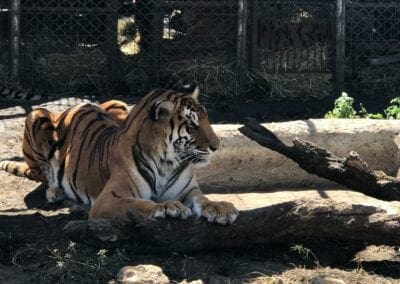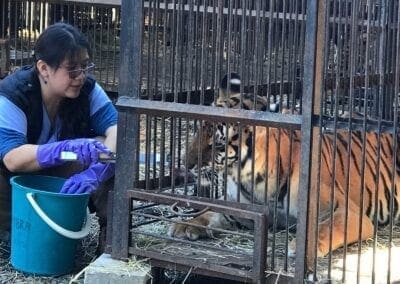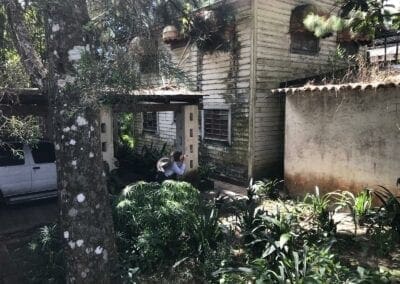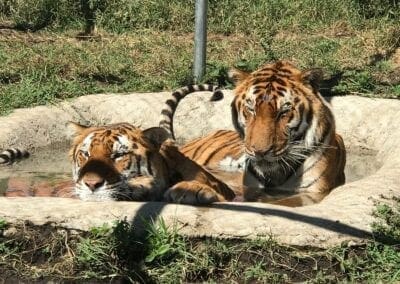


The Animal Defenders International Temporary Rescue Center – Meeting the Tigers and Lions
After the long drive out of the city, through a maze of streets and byways, crowded communities and rural areas, over nice highways and unpaved roads, we finally stop. Our driver jumps out and shouts, and somewhere from the opposite side of a wall a large section slides open. We’re here.
We have arrived at long last at the Animal Defenders International (ADI) Temporary Rescue Center, where over the past many months each rescued lion and tiger has been thoroughly evaluated, cared for and brought back to health. They have finally received treatment for painfully broken teeth, atrophied muscles, malnourishment and trauma they received at human hands.
Here at the Rescue Center they have discovered the joy in playing, laying in the sun, smelling the grass beneath their feet, being with their families and companions, enjoying healthy food, clean homes and clear water.
Mary and I have come all this way to witness what caring can do.
I step down from the truck into the rescue center feeling a little disoriented. It seems, at first, that we’re in the middle of the jungle. Then, through a tall line of trees, I begin to recognize the village of night cages where the lions and tigers are fed and monitored. Behind the night cages I can make out the large fenced-in runs where they live and play.
Men begin emerging from several different directions at once, all moving towards us. At the back of the small house that looks like it grew straight out of the undergrowth, a single dog stands at alert, on duty. His large tail wags welcome. I turn to the sound of a voice. A thin young woman moves towards us swiftly through patches of sunlight that bounce off her ADI hat and t-shirt. She arrives at the truck with a smile. Hand outstretched. This is Yani, ADI’s Temporary Rescue Center Manager, and other go-to person on the ground. Her presence clearly commands the scene.
Jan and Tim introduce us. Yani acknowledges Mary and me warmly and then, without missing a beat, begins updating them on the status of whatever has occurred since their last conversation. While I know nothing of the content, nor should I, what strikes me is the professionalism of the exchange. They are colleagues, urgently working together toward something larger than themselves. It is the well-being of their charges, these 17 lions and tigers, and getting them to the ADI Wildlife Sanctuary in South Africa as quickly and safely as possible that matters.
Both Mary and I relate. We get it. We have both worked in jobs where lives are on the line. The AIDS Epidemic saw each of us deeply engaged in different fronts of the same struggle – Mary was in the labs – I was in the streets. We are here to watch and learn, to photograph and record, to help when and where we can and be part of the solution, not add to the problems. We stand quietly to the side taking in the scope of the operation until Jan is ready to move toward the animals.
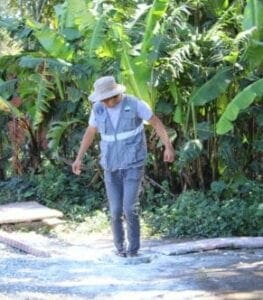 We follow along a narrow trail that stops at a container of lye set into the ground. The lye is a disinfectant to keep us from contaminating the area with something we track in and also keep us from taking any contamination away with us. We step down into it making sure both feet are dusted. No one here takes chances.
We follow along a narrow trail that stops at a container of lye set into the ground. The lye is a disinfectant to keep us from contaminating the area with something we track in and also keep us from taking any contamination away with us. We step down into it making sure both feet are dusted. No one here takes chances.
We enter a large clearing where the animals live and are treated. It is an active village where everyone knows their job and all the focus is on the well-being of each great cat. We come around the empty night cages to the runs to meet the tigers and I am unexpectedly stunned by the ocean of stripes churning before me.
These are huge animals, spinning and charging one another, leaping, playing – an explosion of crisp, bright whites and blacks and yellows that are at once majestic and overwhelming. My senses are momentarily staggered by being exposed to more stripes than I have seen in my life.
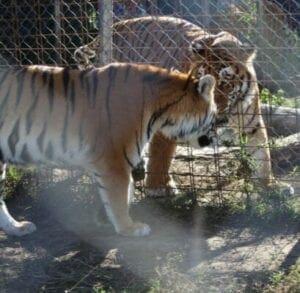 The tigers are regal, magnificent, awesome and… everywhere. “How am I ever going to tell them apart?” I wonder, concerned and a little ashamed. It’s not that “they all look the same” – but they actually do. My brain hasn’t had enough exposure to them to be able to decipher the elaborate patterning that delineates one from another. I know the stripes form their unique signatures but we haven’t been introduced. I don’t know their names.
The tigers are regal, magnificent, awesome and… everywhere. “How am I ever going to tell them apart?” I wonder, concerned and a little ashamed. It’s not that “they all look the same” – but they actually do. My brain hasn’t had enough exposure to them to be able to decipher the elaborate patterning that delineates one from another. I know the stripes form their unique signatures but we haven’t been introduced. I don’t know their names.
Gwynne used to say: “If I know your name, then…” then everything changes. Each one of these beautiful tigers has a name, a story. I am eager to get to know them – together and individually.
Gradually I realize that a few are moving oddly. Stiff-legged. Rocking. I notice where a tail is truncated or crooked. I begin to understand the cost of inbreeding and captivity that is on display.
As I stand there thinking, two of the youngsters are let out to play. They head straight for the pond in the middle of their large enclosure. They’re in the water in a flash – jumping and playing, stalking and splashing, just sitting in the water like little kids grinning. I see how they love the pond, how natural it is for them to be in it, and my heart aches with the grief that not one of them has known the joy of water until ADI created these ponds for them.
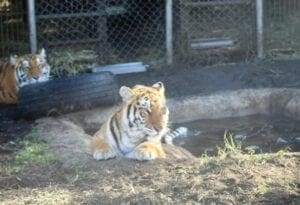 While I have been lost in my thoughts one of the two has come to the fence directly in front of me. She snorts and sniffs. I bend down and offer her the back of my hand. She snuffles it through the fence. I resist the impulse to put my hand in to pet her. As sweet as this moment is, she is a wild animal and capable of doing great damage unintentionally to a creature as frail and flimsy as me. If she hurt me it is she, sadly, who would pay. In any other setting it would cost her life. I am touched and sobered at how curious and trusting she is in this moment, at how powerful the drive is to connect to another.
While I have been lost in my thoughts one of the two has come to the fence directly in front of me. She snorts and sniffs. I bend down and offer her the back of my hand. She snuffles it through the fence. I resist the impulse to put my hand in to pet her. As sweet as this moment is, she is a wild animal and capable of doing great damage unintentionally to a creature as frail and flimsy as me. If she hurt me it is she, sadly, who would pay. In any other setting it would cost her life. I am touched and sobered at how curious and trusting she is in this moment, at how powerful the drive is to connect to another.
The lions appear in the far enclosures. They climb up on their platforms and relax in the sun. I will go to them soon enough, but for now, my heart belongs to the tigers.

Entering the World of An ADI Rescue
 At dawn Mary and I tumbled off the plane and into a different world. As soon as we turn the corner leaving customs, I spot a large, familiar, lion-looking head in the thick of the crowd. It can only be Alexis, Animal Defenders International’s (ADI) Latin American Manager and go-to guy on the ground. Jan and Tim are right there beside him laughing and waving.
At dawn Mary and I tumbled off the plane and into a different world. As soon as we turn the corner leaving customs, I spot a large, familiar, lion-looking head in the thick of the crowd. It can only be Alexis, Animal Defenders International’s (ADI) Latin American Manager and go-to guy on the ground. Jan and Tim are right there beside him laughing and waving.
It is Alexis bounding over to swoop each of us into a huge embrace of welcome that will forever be for me the door opening into this ADI experience. The size of that hug has been the measure of the warmth and thoughtful generosity that starts with Jan and Tim and moves through every aspect of this rescue.
We load into the car and get a mini briefing on the way to the hotel to unpack and get some rest. Tim and Jan encourage everyone to stay some place comfortable during this stage in a rescue when sleep becomes fuel for the clear thinking and intense emotional stamina that are required.
Things will begin to change quickly, a lesson we are about to learn first-hand. That’s just how it is when moving large dangerous animals, animals that have known years of violence and trauma, through multiple jurisdictions. Each has its own protocols. Permits, time-sensitive and slow to get, are always required. Lots and lots of permits. Rules change. Often without announcement or any apparent rationale. Every step is expensive. Politics are involved – always – local, national and certainly, international. Planes are grounded; routes suddenly shutdown.
Most importantly, with every consideration, comes the grim reality that there are people far more dangerous than any of these animals who are lying in wait for any opportunity to kill them.
The awful truth is: these animals are worth far more dead than alive. Poachers and illegal traffickers will kill them and anyone who gets in their way. Jan is a warrior. No one is messing with these animals! Not on her watch! No more. She has seen enough…way too much. Tim has documented most of it and used that documentation to develop strategies and gradually get laws in place all over the globe to end much of this terrible suffering.
The Guibord Center, through our Animals, Faith and Compassion initiative, has a role to play in raising awareness of the need for this work. That’s why Mary and I are here, to learn from the best teachers we can find. That’s also why I have been working so hard with ADI to name the educational center in the new wildlife center in South Africa after my mother. We must change our consciousness – starting with awakening and supporting children in their instinctive connection to nature.
Even before we get to the hotel, we get our first chance to be nimble and adapt to change. The flight out of here in less than four days has been cancelled. Our job right now is to unpack and rest while Jan and Tim explore the multiple layers of backups already falling into place.

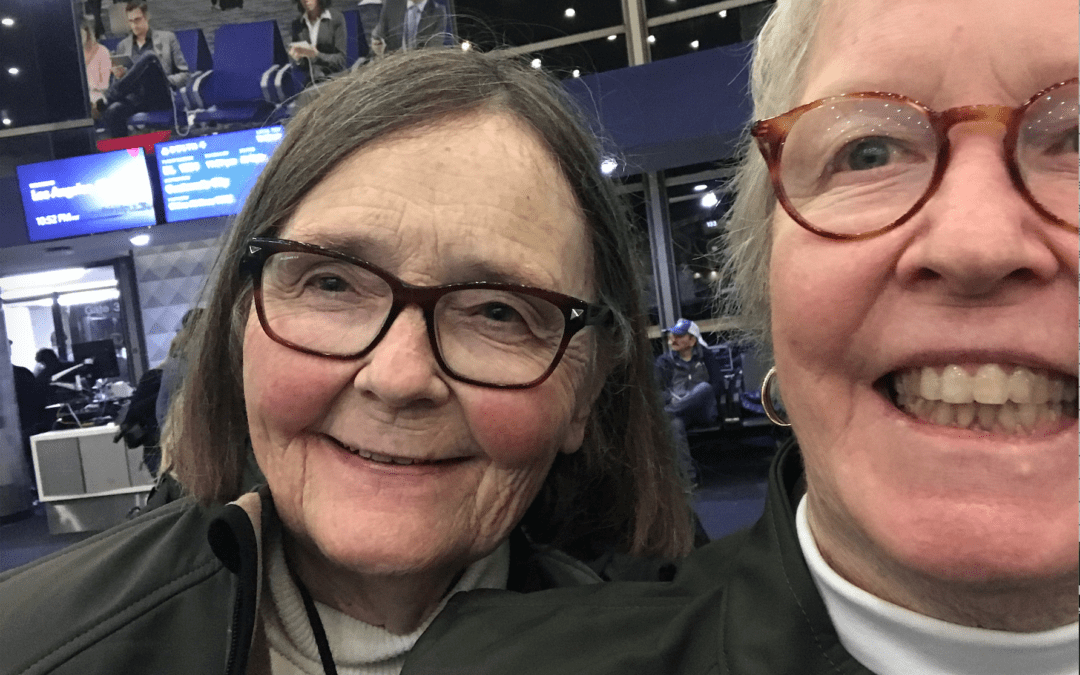
The Journey Begins: Animals, Faith and Compassion on the Frontlines
In the Final Stages of an ADI Rescue
It is a gigantic blur – a dream – but it is real!
WE ARE GOING TO AFRICA!
WE ARE GOING NOW!
Not tomorrow or next week.
NOW.
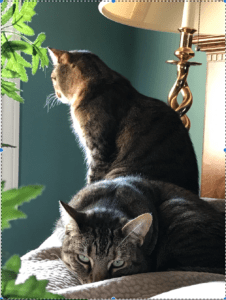 After many months of excited anticipation, unexpected complications and last- minute postponements, suddenly everything is a “go”. I kiss my two “Little Lions” good bye and head out the door. Somehow, I find myself piled into an Uber along with a mountain of luggage in the middle of the night with my dear friend and treasured Guibord Center colleague, Mary Kirchen, racing through LA traffic to try to catch the midnight flight to Guatemala. Yes, at last, this is real!
After many months of excited anticipation, unexpected complications and last- minute postponements, suddenly everything is a “go”. I kiss my two “Little Lions” good bye and head out the door. Somehow, I find myself piled into an Uber along with a mountain of luggage in the middle of the night with my dear friend and treasured Guibord Center colleague, Mary Kirchen, racing through LA traffic to try to catch the midnight flight to Guatemala. Yes, at last, this is real!
This trip was planned nearly two years ago, when Animal Defenders International (ADI) was able to rescue more than a dozen lions and tigers from the circus trade in Guatemala. ADI’s Jan Creamer and Tim Phillips were instrumental in getting legislation passed to outlaw these animals in circuses. As long-time followers of ADI’s important work protecting all kinds of animals, Gwynne and Mary and I knew that The Guibord Center would partner with them to share their work in our Animals, Faith and Compassion Initiative.
Mary and I arrive in Guatemala at dawn, eager to learn more about how this remarkable couple has been able to gather and guide people of conscience across the globe to take action to end so many different forms of cruelty and indifference to animals. I am humbled to play a small part in this work that is changing hearts and minds and culturally engrained habits of cruelty that go back for generations.
It brings tears to my eyes as I write these words. What an incredible privilege and the dream of a lifetime it is to get to be part of this extraordinary passage of restoration and compassion. People of goodness like Jan and Tim and their counterparts all over the world refuse to stand aside while these innocent beings are kidnapped and forced into lives of misery. And we are standing with them.
In my heart I know that this is where The Guibord Center needs to be – not doing the rescues – but supporting these works of compassion – bringing the numerous voices of our many faiths and people of good faith together to speak out in the defense of the defenseless. That’s what spiritual values are all about. We have to find ways to raise our voices of conscience in every country and corner of the world. We have to come together to speak and live the unspoken truth that real satisfaction and safety come in acts of decency and compassion
Compassion begins with animals. It is as simple as that. Animals are the place to begin. Science has discovered that every child is born with a brain designed for spirituality: an acute sensitivity towards something larger than ourselves that unites us to one another in the goodness of life. So, children are born with an instinct for compassion, and we have to nurture it however we can. Animals, it seems to me, are the easiest way to begin. We have to find the words and be the examples.
While our plane flies through the early-morning darkness I think about what lies ahead when we arrive. As the president of The Guibord Center, I contacted the Episcopal Bishop of Guatemala, Bishop Silvestre Romero, before we even booked the flight, to ask him if he would join us in this effort by offering a blessing for these animals, a blessing for all of us and for the dangerous journey of compassion that lies ahead. He graciously agreed – instantly, joyfully, whole-heartedly. He even wrote back to ask if his wife could join him. I laughed out-loud. Of course. I look forward to meeting him in person.
 My colleague in this adventure, Mary, and I have done everything we can so far. It is a gift to have her here with me. She is the best of sports, a great friend and confidant, and she is also sound asleep right now. It’s time for me to try to do the same.
My colleague in this adventure, Mary, and I have done everything we can so far. It is a gift to have her here with me. She is the best of sports, a great friend and confidant, and she is also sound asleep right now. It’s time for me to try to do the same.
My feet were already asleep an hour ago, perched amid the luggage crammed beneath the seat. By sunrise we’ll be on the ground and soon thereafter headed for the compound somewhere in the jungle where we’ll finally get to meet 5 rescued lions and 12 tigers and the people who have taken care of them for these many months. It still seems unreal. But it is no longer a dream.
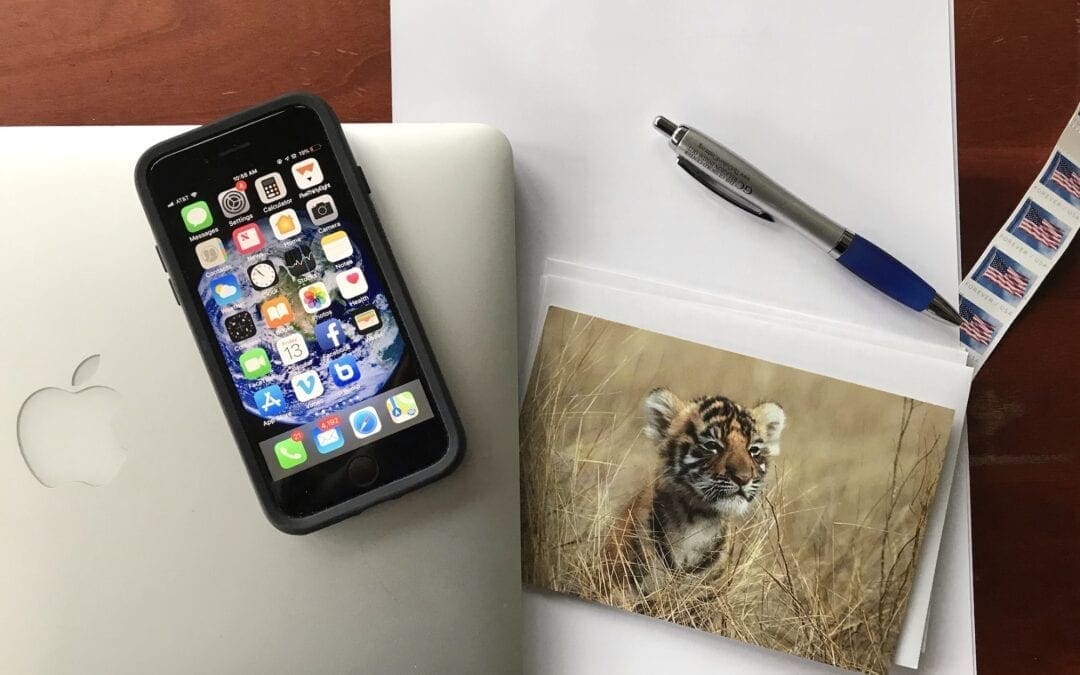
Community in the Time of Coronavirus
Maintaining Connections and Nurturing Relationships
Since The Guibord Center’s beginning, our mission has been about relationships – about breaking down barriers of misunderstanding and bringing people together. Currently, amid coronavirus concerns, we face a different kind of barrier: one of physical separation as community leaders are cancelling events and asking their friends and colleagues to stay home.
Today, after much prayer, we join them in postponing our Annual Celebration Dinner. While I know this is disappointing, it is the right thing to do. We hope to reschedule the dinner once this crisis is under control.
During this difficult time of social distancing, our challenge is to overcome isolation and maintain community, encouragement and much-needed interaction. We at The Guibord Center see this as a time for quiet, prayerful reflection and (re)discovering ways we can nourish our current relationships and build new ones. There are plenty of ways for all of us to reach out, old and new: phone, video conferencing, social media, email, and even old-fashioned postal mail.
Like many other organizations, The Guibord Center is working on ways to continue facilitating community while we’re physically apart. We have been working on a new webinar series that we are launching this month. Its aim is to inspire thoughtful and respectful “courageous conversations” (to borrow a phrase) on timely topics. The initial webinar, “When Worldviews Collide,” is premiering Tuesday, March 31, at 6:30 pm PDT. Learn how you can join us and register here.
The Guibord Center is committed to supporting community by doing what we can to offer ways to connect, interact, and uplift one another. While we may be apart, let’s remember we’re not alone.
Dr. Lo Sprague


